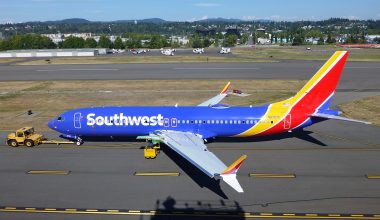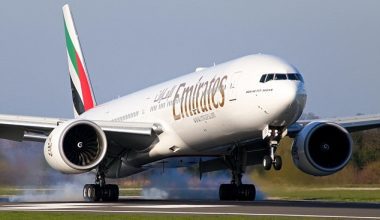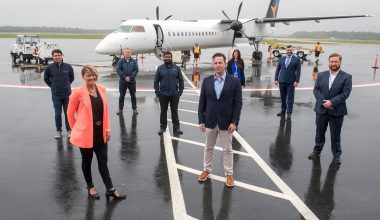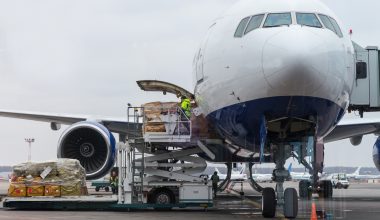De Havilland DHC-6 Twin Otter is a staple of STOL (short takeoff and landing) flying. It is a high-wing, twin-engine utility aircraft mostly used in areas with difficult flying conditions. The sturdy Twin Otter is designed for remote environments and offers a crucial transportation lifeline to rural communities. The Canadian STOL utility aircraft is versatile and can tackle various missions in challenging environments.

DHC-6 Twin Otter is highly regarded for its incredible STOL performance, versatility, reliability, and robustness. Due to its rugged construction, it can withstand demanding conditions and operate in diverse environments worldwide. Airline companies can rely on Twin Otter to expand their flight services to far-flung destinations.
Development of de Havilland Canada DHC-6 Twin Otter
DHC-6 Twin Otter is one of Canada’s greatest-selling commercial aircraft designs developed by De Havilland Canada. In 1964, the Canadian aerospace company initiated development work on DHC-6 as a twin-engine replacement for the single-engine DHC-3 Otter. The new STOL commuter airliner and utility transport featured stretched wings, redesigned nose, and increased seating capacity. Double-slotted trailing-edge flaps and flaperons were added to enhance the STOL capability and make the aircraft uniquely suited to the severe Canadian operating environment.
Also Read: Evergreen STOL Aircraft for Nepal; Twin Otter
The DHC-6 prototype flew for the first time on May 20, 1965, and secured certification in mid-1966. The first Twin Otter variant, the Series 100, was fitted with two 550hp PT6A-20 turboprop engines. The Series 200, introduced in April 1968, used the same engines but incorporated improvements like an extended nose, reconfigured rear baggage compartment, etc.

The Series 300 used more powerful PT6A-27 turboprop engines, offering greater aircraft performance and payload. Adopting two 680shp PT6A-27 engines increased the takeoff weight by 450 kg (1,000 lb) and maximum cruise speed to 338km/hr.
After the 23-year production run, the Canadian plane maker pulled the plug on DHC-6 Twin Otter’s manufacturing in 1988. It produced 844 DHCs (Series 100-300) between 1965 and 1988.
Restarting the Twin Otter production
In 2005, British Columbian company Viking Air acquired the type certifications for seven discontinued DHC designs, including the Twin Otter. The ownership of the DHC Type Certificates gave Viking the right to manufacture any of seven out-of-production DHC legacy aircraft if new market opportunities arose.
Shortly afterward, the company conducted extensive market research to assess demand for each DHC heritage aircraft. The existence of overwhelming demand propelled Viking Air to restart Twin Otter production. On April 2, 2007, Viking announced the revival of the production of the legendary two-engined Twin Otter with the launching of the Series 400 production program.

The first flight of the new production, Series 400 Twin Otter, took place on February 1, 2010. The inaugural flight marked the return of the new Twin Otter to the skies in 22 years. Fitted with more powerful PT6A-34/35 engines, the Series 400 turboprop featured Honeywell’s Primus Apex IFR digital flight deck. Zimex Aviation of Switzerland became the launch customer by receiving the first new-generation plane in July 2010. The Swiss airline earmarked the latest turboprop variant for oil and gas exploration duties throughout North Africa.
DHC-6 Twin Otter Series 400 specifications
The Viking-produced new Series 400 Twin Otter measures 51 ft 9 inches long and can seat 19 passengers. It can cruise over 337km/hour and fly far for up to 790 nmi (1480km). The aircraft owes its increased range capacity and cruise speed to using advanced PT6A-34 engines that power it.
The STOL utility aircraft has a payload and fuel capacity of 1,842km and 378 US gallons, respectively. The Series 400 has improved performance and design features compared to its earlier siblings. Besides adopting powerful engines, the Series 400 turboprops feature modern electrical and lighting systems, composite doors, advanced avionics, etc.
No. of Twin Otters built
DHC-6 Twin Otter is still in production thanks to its unparalleled dependability and versatility. The turboprop is the best-selling 19-passenger aircraft, with more than 900 examples built. De Havilland Canada built 844 Twin Otters (Series 100-300) between 1965 and 1988. Similarly, Viking Air has delivered more than 141 Twin Otters (Series 400) since 2008.
Variant-wise, the Series 300 has outsold all other versions, with 614 units sold before the production end in 1988. The Series 300 aircraft can accommodate 20 passengers and has a payload capacity of 1,135 kg over 1,287km.
Applications of Twin Otter
Twin Otter is a versatile machine that can excel in various missions and operating conditions. It is often termed a ‘bush’ plane due to its ability to provide passenger and flight services to remote and challenging locations. This iconic Canadian plane can handle adverse climates, from North Africa’s hottest deserts to the extreme colds of Antarctica.
Commuter airlines can deploy Twin Otter to serve the network of short-field airports. Mainline carriers can use this aircraft to provide connecting feeder service and cater to communities where air travel is the optimum transport mode.

Besides regional commuter flight roles, Twin Otters can be modified to perform various missions such as search &rescue, surveillance, scientific research, etc. Operators can outfit the turboprop with mission-specific equipment to suit their needs.
Depending on customers’ needs, some Twin Otters come up with float and ski configurations directly from the factory. The float/ski-equipped aircraft can operate easily in remote areas with water bodies or snow-covered landscapes.
Some Twin Otters have found their role in the skydiving realm. Operators in many countries use the aircraft for commercial skydiving operations.
Hence, Twin Otter has many applications and is adaptable to numerous mission profiles. Apart from passenger transportation, operators can use this sturdy turboprop for surveillance, military, air rescue missions, etc.
Operators of Twin Otter aircraft
The rugged Twin Otter aircraft appeals to various customers, from commuter airlines to large scheduled passenger airlines. Its excellent operating economics and outstanding reliability make it a favorite airline turboprop.
Operators of Twin Otters are diverse and include regional airlines, private charter companies, military forces, etc. Currently, the largest civil operators of this STOL commuter are as follows:
- Trans Maldivian Airways (50+ Twin Otters, available in -100, -200, -300, and -400 series)
- Kenn Borek Air (15+ examples, available in series 100, 300, and 400)
- Grand Canyon Airlines (13 DHC-6 Twin Otters)
- Maldivian (11 DHC-6 Twin Otter Series 300)
- Zimex Aviation (11 DHC-6-300 Twin Otters)
- Transwest Air (6 DHC-6 Twin Otter, available in Series 100, 200, and 300)
As of 2020, the Asia Pacific region hosts the highest number of Twin Otters (142) in the world. It is followed by the Americas (110), Europe (37), Africa (22), and the Middle East (4).
Role-wise, around 38% of in-service Twin Otters serve as regional airliners. Likewise, 31% are deployed in military or special missions. Similarly, those used in industrial support comprise 26% of active Twin Otters. Private air charter companies operate the remaining 5%.
Twin Otter in Nepal
DHC-6 Twin Otter is ideal for serving remote mountain airfields of Nepal. The rugged Canadian-built twin jet has played an instrumental role in opening up the Himalayan Kingdom’s hinterlands. Its robust airframe and STOL capability make it suitable for operations in remote and rugged locations of Nepal.
Nepal is geographically complex and is predominantly a rural society. Nepal’s airports situated at high altitudes have short runways due to uneven geographical landscapes. For years, DHC Twin Otter has kept these STOL airports humming with regular movement of passengers and cargo from/to major cities. Thanks to its excellent STOL capabilities, the sturdy turboprop aircraft can be shoehorned on and off short runways and rough airstrips of Nepalese airports. This versatile aircraft is well-suited to accessing tough and treacherous structures and connecting remote and isolated communities in Nepal.
Currently, two airlines operate Twin Otter aircraft in Nepal. They are:
Nepal Airlines (2 DHC-6-300 Twin Otters)
Tara Air (2 DHC-6-300 Twin Otters and 1 DHC-6-400 Twin Otter)
Nepal Airlines, the flag carrier of Nepal, deploys two turboprops (9N-ABT and 9N-ABU) on the domestic network. This aircraft clocks in over 38 years on average and features 19 seats in an all-economy configuration. These high-wing, twin-engine utility airliners form the backbone and have been the mainstay of the carrier’s domestic operations for many years.
Nepal Airlines welcomed its first DHC-6 in 1971 and has since been utilizing the aircraft for domestic operations. The Kathmandu-based carrier flies DHC6 turboprops regularly to cities like Bhojpur, Dang, Taplejung, Khandidanda, Rukum, Thamkharka, Phaplu, Ilam, Resunga, etc.
Tara Air, the privately-owned Nepalese carrier, operates many scheduled and chartered flights using Twin Otters. It is the first Nepalese carrier to purchase Viking Series 400 Twin Otter, whose production started in 2008. Tara uses a mix of DHC-6/400 and DHC-6/300 aircraft to operate a network of flights to key Nepalese tourist destinations and remote STOL sectors.






